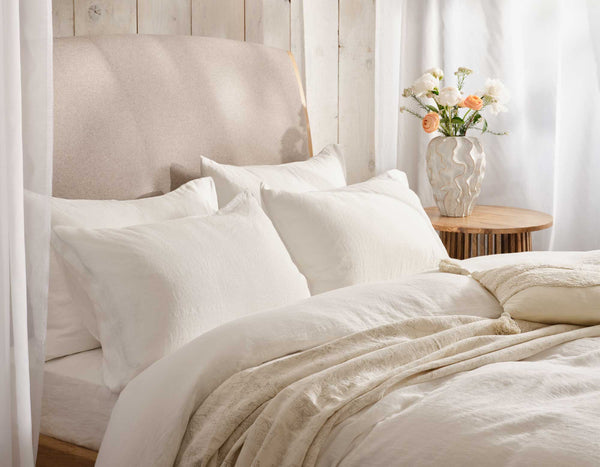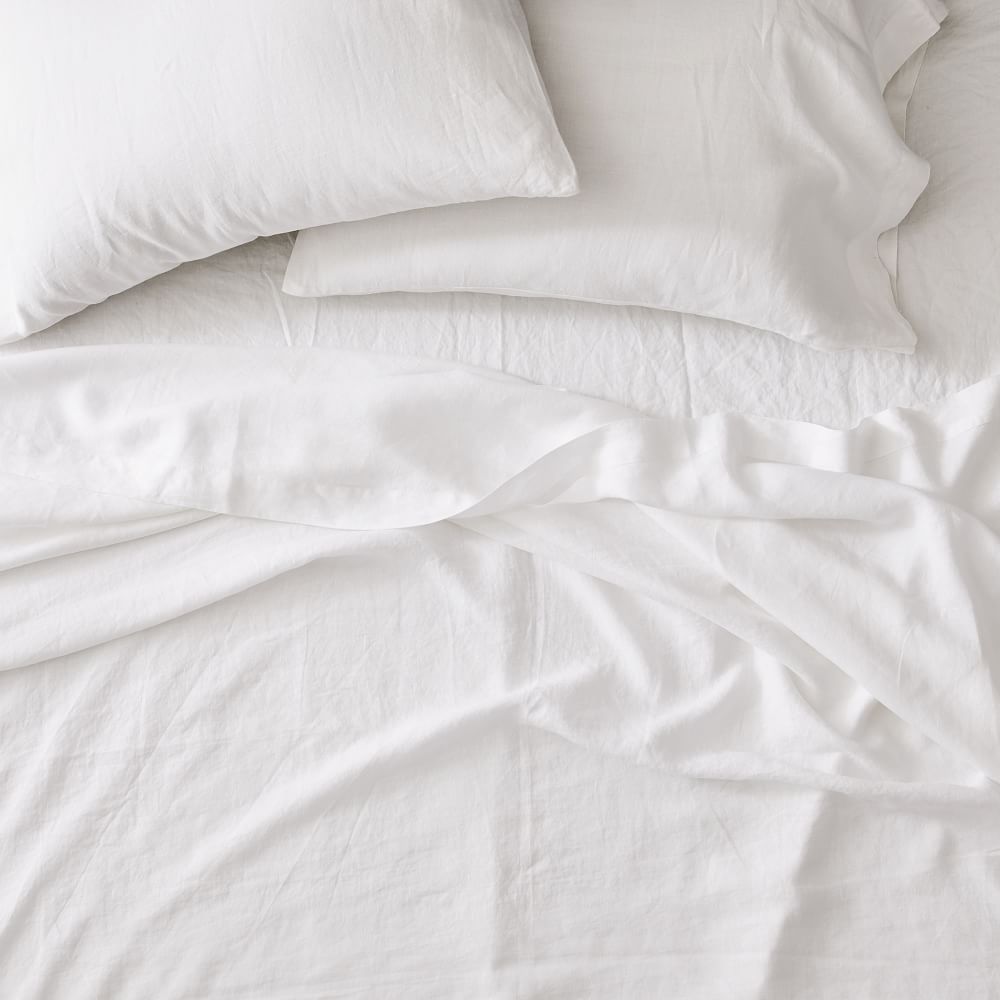Why Shoppers Across Sydney Are Switching to Linenshed
Why Shoppers Across Sydney Are Switching to Linenshed
Blog Article
Comprehending Linen: The Eco-Friendly Option for Comfortable Living
When you think of environmentally friendly fabrics, bed linen usually attracts attention for its distinct qualities. This natural textile, made from the flax plant, uses both comfort and sustainability. Its exceptional properties make it an excellent option for warm climate and resilient use. What truly establishes bed linen apart from other products? Comprehending its origins and benefits can transform just how you view home textiles. Allow's explore the fascinating world of bed linen further.
The Beginnings of Linen: From Flax to Material

Bed linen, one of the oldest fabrics understood to humanity, has a remarkable journey that begins with the modest flax plant. Once collected, the flax stalks undertake a process called retting, where they're saturated to divide the fibers from the woody components.
When you see bed linen fabric, you're observing centuries of craftsmanship. The weaving procedure transforms those spools of string right into the beautiful, resilient fabric you like. Linen has actually been cherished for its natural look and really feel, making it a favorite for everything from clothing to home fabrics. So, following time you touch bed linen, remember its abundant history that links you to ancient cultures and their typical techniques - Linen.
The Special Quality of Linen
One of the standout attributes of this exceptional fabric is its breathability. When you wear bed linen, you'll discover exactly how it permits air to circulate, keeping you cool on warm days. This residential or commercial property makes it a perfect option for summer apparel and bedding.
Linen additionally flaunts outstanding moisture-wicking capabilities, drawing sweat away from your skin and permitting it to evaporate promptly. You won't really feel clammy, even in moist conditions. In addition, linen is sturdy, typically becoming softer and a lot more comfortable with each wash, which suggests it can stand the test of time in your closet.
One more special element is its natural texture; the slight abnormalities give linen a personality that boosts your style. Plus, it stands up to creases much better than many various other fabrics, so you can enjoy a kicked back yet polished appearance without much initiative. Accept linen, and you'll appreciate its comfort and special beauty.
Ecological Advantages of Linen
When you choose bed linen, you're not simply going with a gorgeous material; you're additionally sustaining sustainable production methods. Bed linen's naturally degradable and compostable nature makes it a clever choice for the environment. Plus, it needs considerably less water to create compared to various other fabrics, aiding preserve this priceless resource.
Sustainable Production Practices
Although numerous materials have substantial ecological impacts, linen sticks out as a result of its lasting production methods. When you pick linen, you're choosing a material made from the flax plant, which needs minimal water and chemicals. This resistant crop can flourish in bad soil conditions, reducing the requirement for chemical plant foods. Furthermore, the entire flax plant is used in production, minimizing waste and advertising source effectiveness.
Linen manufacturing is frequently much less energy-intensive contrasted to various other textiles, as it entails natural processes instead of artificial treatments. By supporting linen, you're adding to a much more sustainable textile industry that prioritizes eco-friendly methods. Choosing bed linen not only enhances your convenience however also aligns your values with environmental duty.
Compostable and naturally degradable Material
Bed linen's eco-friendly nature extends beyond its sustainable production; it's compostable and additionally eco-friendly, making it an outstanding option for ecologically aware customers. When you pick linen products, you're opting for materials that damage down naturally, returning nutrients to the earth. Composting bed linen can enrich dirt, advertising healthy and balanced plant development.
Low Tide Intake
One of the standout advantages of linen is its low water consumption throughout growing. Unlike cotton, which requires significant watering, linen's flax plant grows on very little water, making it an extra lasting option. You'll appreciate understanding that for every heap of linen generated, substantially less water is required compared to many various other textiles.
Bed linen vs. Other Fabrics: A Comparison
When you contrast linen to various other materials, you'll see its superior breathability and comfort, making it excellent for warm weather. Plus, bed linen sticks out for its resilience and long life, typically outliving numerous frequently used products. As you consider your options, the ecological impact of each fabric will also play a vital duty in your decision.
Breathability and Comfort
Linen stands out among materials for its amazing capacity to permit air flow. Unlike artificial fabrics, which can trap heat and dampness, bed linen's natural fibers wick away sweat, keeping you cool and dry.
Cotton is often commended for its softness, but it doesn't match linen's breathability. Even blends might not offer the exact same ventilation. If you focus on comfort, specifically in summertime, linen must be your go-to option. It not just keeps you really feeling fresh but also brings a classic sophistication to your wardrobe.
Sturdiness and Long Life
While several materials provide differing degrees of durability, linen absolutely stands out in durability, making it a sensible financial investment for your closet. Unlike cotton or artificial products that might break promptly, bed linen obtains stronger with each wash. Its natural fibers stand up to fraying and fading, ensuring your garments look terrific over time. You'll find that bed linen's breathable nature also lowers wear from sweat and wetness, which can damage various other fabrics. And also, its capability to stand up to high temperature levels suggests it will not diminish quickly in the dryer. You're choosing for a resistant material that can handle daily usage while preserving its appeal when you choose linen. Believe me, your long-lasting investment in bed linen will pay off with years of fashionable, comfortable wear.
Environmental Impact Comparison
Although many fabrics add to ecological concerns, bed linen stands apart for its environment-friendly high qualities. Unlike cotton, which calls for substantial water resources and chemicals, linen is made from flax, a plant that prospers on very little water and needs fewer chemicals. This suggests you can really feel good regarding your selection while decreasing your carbon footprint.
When contrasted to artificial materials like polyester, linen's biodegradability beams. While polyester can take centuries to decompose, bed linen breaks down naturally, returning nutrients to the soil.
Choosing linen not just advertises lasting farming methods but additionally sustains a healthier planet. By choosing bed linen over standard fabrics, you're making an aware choice that benefits both your convenience and the setting.
Taking care of Your Linen Textiles
To ensure your linen textiles stay in great problem, you'll want to comply with some straightforward care standards. Clean your bed linen in cool water on a gentle cycle to stop it from reducing or shedding its shape.
When it concerns drying, air drying is ideal. If you utilize a clothes dryer, choose a low warm setting and remove the things while they're still somewhat damp to reduce creases. Iron the linen while it's still damp for much easier handling, or vapor it to maintain it looking crisp.
For storage, maintain your linen in a great, dry place. Avoid straight sunshine to avoid fading. With these easy practices, your linen fabrics will maintain their beauty and last for several years, making them a sustainable enhancement to your way of living.
Integrating Bed Linen Into Your Home Décor
Taking care of your bed linen textiles not only protects their quality yet also opens up a globe of possibilities for incorporating them right into your home décor. You can begin little by adding linen toss pillows to your sofa, quickly raising the space with structure and warmth. Take into consideration bed linen drapes that filter sunshine magnificently, producing a soft, ventilated environment in any type of room.
For a more rustic look, try making use of bed linen tablecloths or joggers throughout meals; they add an elegant touch and are very easy to tidy. If you're really feeling daring, mix and suit different bed linen shades discover here and patterns to create a distinct, split effect.
Don't neglect regarding linen blankets-- drape one over a chair or your bed for an inviting feel. By thoughtfully integrating bed linen into your style, you enhance both convenience and design, making your home a calm hideaway.
The Future of Bed Linen in Sustainable Living
As customers significantly prioritize sustainability, linen emerges as a frontrunner in environment-friendly textiles. Its production utilizes less water and pesticides compared to traditional cotton, making it an extra environmentally accountable selection. As you look in the direction of a sustainable future, integrating linen into your closet and home can significantly minimize your carbon footprint.
Cutting-edge brands are now concentrating on lasting techniques, from using organic flax to implementing circular economy concepts. You'll discover that bed linen's longevity implies it lasts much longer, lowering the requirement for frequent substitutes.
In addition, as even more people embrace minimalist way of livings, linen's ageless allure and flexibility will certainly keep it appropriate. By choosing bed linen, you're not just opting for convenience; you're likewise supporting sustainable techniques.
In the upcoming years, the demand for bed linen is anticipated to expand, strengthening its area in an extra eco-conscious world. Think about making linen a staple in your sustainable living journey.
Often Asked Questions
Is Bed Linen Suitable for People With Allergies?
Yes, bed linen's natural look at more info fibers are hypoallergenic, making it appropriate for people with allergies. Its breathable nature helps in reducing wetness and microorganisms build-up, adding to a healthier resting environment. You'll likely locate it safe and comfortable.
Can Linen Be Dyed Easily?
Yes, you can dye linen conveniently. Its natural fibers absorb dyes well, allowing for vibrant colors. Just make specific you utilize the best dye kind and comply with correct methods to attain the desired outcomes without damaging the fabric.
Just How Does Bed Linen Compare in Longevity to Cotton?

What Weight of Linen Is Finest for Summer Season Clothes?
For summer clothes, light-weight linen around 4 to 5 ounces per backyard is suitable. It maintains you great, breathable, and comfortable in heat (Linen). You'll value just how it drapes and actions with you effortlessly

Can Linen Be Made Use Of for Outdoor Furnishings?
Yes, you can use bed linen for outdoor furniture. It's breathable and long lasting, making it an excellent option for cozy weather condition. Just make certain to select a treated version to stand up to the elements and preserve its look.
Verdict
Incorporating bed linen into your life not just boosts your comfort yet also supports an extra lasting future. With its one-of-a-kind residential properties and marginal ecological impact, linen is a clever option for your home décor and lifestyle.
Linen's compostable and naturally degradable nature makes it a smart choice read this article for the environment. By integrating bed linen into your home, you're not just enjoying its convenience and resilience; you're additionally supporting environmentally friendly practices and helping create a much healthier earth. The Future of Bed Linen in Lasting Living.

Report this page